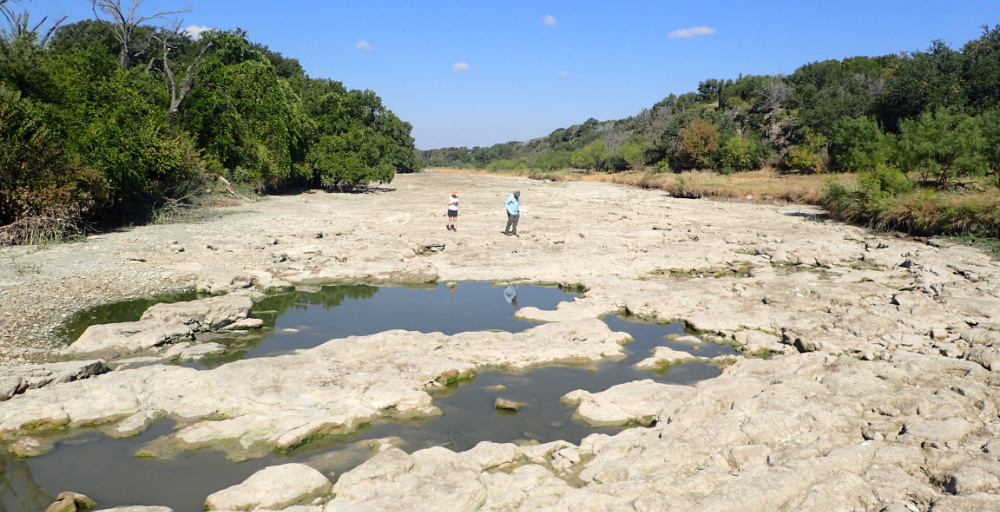
The following table provides the history of excessive, illegal and wasteful pumping and diversion of the San Saba River by Menard irrigators and responses from the Texas Commission on Environmental Quality (TCEQ) and downstream riparian landowners with superior Domestic & Livestock water rights (D&L users).
1994 to 2000
Menard Irrigation Company (MIC) Canal exceeds over 2.5 times its diversion limit annually.
2001
TCEQ finds the MIC Canal is losing 30-35% of all water diverted into the Canal. MIC admits loss rate in canal likely exceeds 50%
2001
Senior downstream D&L users and riparian landowners form San Saba Water Conservation Association and submit a petition to TCEQ for appointment of a watermaster on the upper San Saba River.
2001 to 2011
MIC does not make improvements to its Canal that were requested by TCEQ
2004
Upstream Menard irrigators promise to install and maintain a meter on the San Saba River and reduce upstream diversions when water flow drops at that meter. The installed meter “disappears”, is never replaced and no reductions in diversions are made by upstream Menard irrigators to protect downstream flows.
2006 to 2011
Downstream D&L users annually file “Priority Calls” with TCEQ due to insufficient flow on the San Saba River to satisfy domestic or livestock needs
2011
On August 8, 2011, TCEQ for the first time suspends diversions by the MIC Canal and suspends upstream pumping by Menard irrigators. TCEQ investigations confirm no meter or control device was ever installed on the MIC Canal, no actions were taken to address water losses in the Canal, and investigation identifies numerous unauthorized alluvial wells along the MIC Canal and San Saba River diverting state-owned water.
2011
The U.S. Fish and Wildlife Service (USFWS) begins evaluating the status of Central Texas freshwater mussels under the Endangered Species Act.
2012
Downstream D&L users file “Priority Calls” with TCEQ after the San Saba River runs dry. TCEQ refused to suspend upstream diversions and pumping because it did not believe water flow would reach D&L users downstream even though water flow resumed in 2011 after the TCEQ suspension.
2012
Friends of the San Saba (FOSS) is formed after numerous years of the river going dry in summer months and ineffective enforcement by TCEQ.
2013
FOSS engages RPS Espey to complete a hydrologic analysis of the San Saba River, which confirms the existence of 104 alluvial wells along the MIC Canal and San Saba River near Menard. The analysis concludes the river should maintain flow, even in droughts, if illegal pumping and abuse in and around Menard were stopped.
2013
American Rivers designates the San Saba River the third most endangered river in the United States due to wasteful water use and unregulated pumping by upstream irrigators
2013
For the second time, TCEQ suspends diversions by the MIC Canal and suspends upstream pumping by Menard irrigators after receiving “Priority Calls” from downstream D&L users.
2013
TCEQ issues a notice of violation to MIC for exceeding its annual diversion limit again and TCEQ closes the MIC Canal diversion point.
2014
MIC agrees to correct its water use reporting and agrees to assist TCEQ with the installation of a canal diversion gate and measuring device.
2014
TCEQ closes the MIC Canal after it exceeds its annual diversion limit again. MIC stops diverting San Saba River water and the Canal remains closed today. After TCEQ closed the MIC Canal in 2013 and 2014, flow returned to the San Saba River below Menard.
2015
Downstream D&L users file “Priority Calls” with TCEQ due to disappearing downstream flow, but calls are denied by TCEQ despite suspensions in 2011 and 2013. TCEQ staff denied the priority calls claiming D&L users had access to one or two muddy potholes that held some water in an otherwise dried up river bed.
2015
TCEQ investigates and issues violation notices to several Menard property owners who took surface water from the San Saba River with unpermitted alluvial wells. TCEQ concludes that unpermitted alluvial wells near Menard are the likely cause of water flow loss along this section of the San Saba River.
2015
Texas Parks & Wildlife (TPWD) investigates and inspects the San Saba River south of Menard and notes the threat to endangered freshwater mussels due to absence of flow and only isolated stagnant pools of water to shelter aquatic life over an extended reach of the San Saba River.
2017
TCEQ conducts a five year watermaster evaluation for the Colorado River Basin, including the San Saba River. FOSS members argued a watermaster was needed, but TCEQ’s position is that threats to D&L users’ superior water rights cannot be considered in watermaster evaluation criteria. TCEQ did not create a watermaster for the San Saba River after Menard irrigators objected.
2018
The Texas House of Representatives Committee on Natural Resources conducts a hearing on May 23, 2018 in Brady. Testimony was provided by upstream and downstream landowners on the San Saba River, state agencies, hydrologists and other experts.
2021
On August 24, 2021, the USFWS issues a proposed federal rule to protect six central Texas freshwater mussels under the Endangered Species Act, including four species that are either currently present or found to have existed in the San Saba River.

